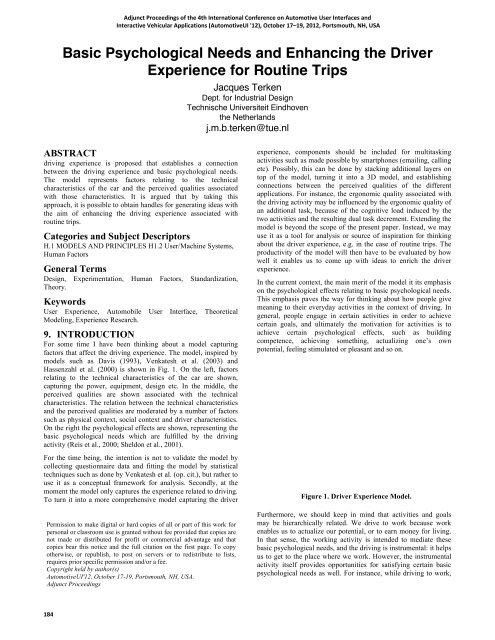12: Adjunct Proceedings - Automotive User Interfaces and ...
12: Adjunct Proceedings - Automotive User Interfaces and ...
12: Adjunct Proceedings - Automotive User Interfaces and ...
Create successful ePaper yourself
Turn your PDF publications into a flip-book with our unique Google optimized e-Paper software.
Basic Psychological Needs <strong>and</strong> Enhancing the Driver<br />
Experience for Routine Trips<br />
ABSTRACT<br />
driving experience is proposed that establishes a connection<br />
between the driving experience <strong>and</strong> basic psychological needs.<br />
The model represents factors relating to the technical<br />
characteristics of the car <strong>and</strong> the perceived qualities associated<br />
with those characteristics. It is argued that by taking this<br />
approach, it is possible to obtain h<strong>and</strong>les for generating ideas with<br />
the aim of enhancing the driving experience associated with<br />
routine trips.<br />
Categories <strong>and</strong> Subject Descriptors<br />
H.1 MODELS AND PRINCIPLES H1.2 <strong>User</strong>/Machine Systems,<br />
Human Factors<br />
General Terms<br />
Design, Experimentation, Human Factors, St<strong>and</strong>ardization,<br />
Theory.<br />
Keywords<br />
<strong>User</strong> Experience, Automobile <strong>User</strong> Interface, Theoretical<br />
Modeling, Experience Research.<br />
9. INTRODUCTION<br />
For some time I have been thinking about a model capturing<br />
factors that affect the driving experience. The model, inspired by<br />
models such as Davis (1993), Venkatesh et al. (2003) <strong>and</strong><br />
Hassenzahl et al. (2000) is shown in Fig. 1. On the left, factors<br />
relating to the technical characteristics of the car are shown,<br />
capturing the power, equipment, design etc. In the middle, the<br />
perceived qualities are shown associated with the technical<br />
characteristics. The relation between the technical characteristics<br />
<strong>and</strong> the perceived qualities are moderated by a number of factors<br />
such as physical context, social context <strong>and</strong> driver characteristics.<br />
On the right the psychological effects are shown, representing the<br />
basic psychological needs which are fulfilled by the driving<br />
activity (Reis et al., 2000; Sheldon et al., 2001).<br />
For the time being, the intention is not to validate the model by<br />
collecting questionnaire data <strong>and</strong> fitting the model by statistical<br />
techniques such as done by Venkatesh et al. (op. cit.), but rather to<br />
use it as a conceptual framework for analysis. Secondly, at the<br />
moment the model only captures the experience related to driving.<br />
To turn it into a more comprehensive model capturing the driver<br />
Permission to make digital or hard copies of all or part of this work for<br />
personal or classroom use is granted without fee provided that copies are<br />
not made or distributed for profit or commercial advantage <strong>and</strong> that<br />
copies bear this notice <strong>and</strong> the full citation on the first page. To copy<br />
otherwise, or republish, to post on servers or to redistribute to lists,<br />
requires prior specific permission <strong>and</strong>/or a fee.<br />
Copyright held by author(s)<br />
<strong>Automotive</strong>UI'<strong>12</strong>, October 17-19, Portsmouth, NH, USA.<br />
<strong>Adjunct</strong> <strong>Proceedings</strong><br />
Copyright 2010 ACM 1-58113-000-0/00/0010 …$15.00.<br />
184<br />
<strong>Adjunct</strong> <strong>Proceedings</strong> of the 4th International Conference on <strong>Automotive</strong> <strong>User</strong> <strong>Interfaces</strong> <strong>and</strong><br />
Interactive Vehicular Applications (<strong>Automotive</strong>UI '<strong>12</strong>), October 17–19, 20<strong>12</strong>, Portsmouth, NH, USA<br />
Jacques Terken<br />
Dept. for Industrial Design<br />
Technische Universiteit Eindhoven<br />
the Netherl<strong>and</strong>s<br />
j.m.b.terken@tue.nl<br />
experience, components should be included for multitasking<br />
activities such as made possible by smartphones (emailing, calling<br />
etc). Possibly, this can be done by stacking additional layers on<br />
top of the model, turning it into a 3D model, <strong>and</strong> establishing<br />
connections between the perceived qualities of the different<br />
applications. For instance, the ergonomic quality associated with<br />
the driving activity may be influenced by the ergonomic quality of<br />
an additional task, because of the cognitive load induced by the<br />
two activities <strong>and</strong> the resulting dual task decrement. Extending the<br />
model is beyond the scope of the present paper. Instead, we may<br />
use it as a tool for analysis or source of inspiration for thinking<br />
about the driver experience, e.g. in the case of routine trips. The<br />
productivity of the model will then have to be evaluated by how<br />
well it enables us to come up with ideas to enrich the driver<br />
experience.<br />
In the current context, the main merit of the model it its emphasis<br />
on the psychological effects relating to basic psychological needs.<br />
This emphasis paves the way for thinking about how people give<br />
meaning to their everyday activities in the context of driving. In<br />
general, people engage in certain activities in order to achieve<br />
certain goals, <strong>and</strong> ultimately the motivation for activities is to<br />
achieve certain psychological effects, such as building<br />
competence, achieving something, actualizing one’s own<br />
potential, feeling stimulated or pleasant <strong>and</strong> so on.<br />
Figure 1. Driver Experience Model.<br />
Furthermore, we should keep in mind that activities <strong>and</strong> goals<br />
may be hierarchically related. We drive to work because work<br />
enables us to actualize our potential, or to earn money for living.<br />
In that sense, the working activity is intended to mediate these<br />
basic psychological needs, <strong>and</strong> the driving is instrumental: it helps<br />
us to get to the place where we work. However, the instrumental<br />
activity itself provides opportunities for satisfying certain basic<br />
psychological needs as well. For instance, while driving to work,





